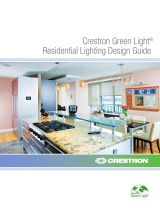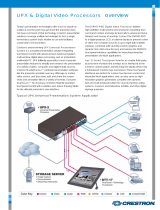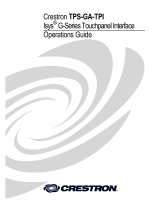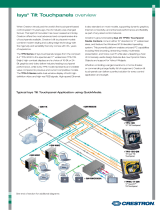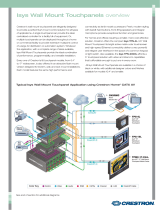Page is loading ...

Crestron Isys
®
TPS-3000
6.4 Inch Tilt Touchpanel
Operations Guide

This document was prepared and written by the Technical Documentation department at:
Crestron Electronics, Inc.
15 Volvo Drive
Rockleigh, NJ 07647
1-888-CRESTRON
All brand names, product names and trademarks are the property of their respective owners.
©2005 Crestron Electronics, Inc.

Crestron Isys
®
TPS-3000 6.4 Inch Tilt Touchpanel
Contents
6.4 Inch Tilt Touchpanel: Crestron Isys
®
TPS-3000 1
Introduction ...............................................................................................................................1
Features and Functions................................................................................................ 1
Specifications ..............................................................................................................2
Physical Description....................................................................................................5
Industry Compliance ................................................................................................... 9
Setup .......................................................................................................................................... 9
Network Wiring........................................................................................................... 9
Identity Code ............................................................................................................. 10
Configuring the Touchpanel......................................................................................10
Hardware Hookup .....................................................................................................17
Recommended Touchscreen Cleaning ...................................................................... 20
Tilt Angle Tension Adjustment ................................................................................. 21
Programming Software ............................................................................................................21
Earliest Version Software Requirements for the PC .................................................22
Programming with Crestron System Builder............................................................. 22
Programming with SIMPL Windows ........................................................................23
Programming with VisionTools Pro-e....................................................................... 27
Reserved Join Numbers.............................................................................................28
MultiByte International Characters ........................................................................... 31
Uploading and Upgrading........................................................................................................ 31
Communication Settings ...........................................................................................32
Uploading a SIMPL Windows Program to a Control System ................................... 34
Uploading a VT Pro-e Project ...................................................................................35
Firmware Upgrade..................................................................................................... 37
Problem Solving ...................................................................................................................... 39
Troubleshooting......................................................................................................... 39
Further Inquiries ........................................................................................................40
Future Updates ..........................................................................................................40
Software License Agreement...................................................................................................41
Return and Warranty Policies ..................................................................................................43
Merchandise Returns / Repair Service ...................................................................... 43
CRESTRON Limited Warranty.................................................................................43
Operations Guide – DOC. 6076A Contents • i


Crestron Isys
®
TPS-3000 6.4 Inch Tilt Touchpanel
6.4 Inch Tilt Touchpanel:
Crestron Isys
®
TPS-3000
Introduction
Features and Functions
The TPS-3000 is a member of the signature family of Crestron
®
touchpanels. It packs
all the power and performance of an Isys
®
touchpanel in a stylish model that offers
amazing ergonomics and one-hand control. Its compact stature makes the TPS-3000
perfect for the home, especially in locations like home theaters, bedrooms and the
home office.
Functional Summary
•
6.4" (1.26 cm) active matrix color display
• 65,563 colors
• 640 x 480 screen resolution
• 16-bit non-palette graphics
• 8 Mb of Flash & 8 Mb of DRAM memory
• Built-in time-based correction for stable video and graphics
• Balanced/unbalanced composite video and S-video input; supports
NTSC/PAL formats
• Full screen video capability
• Up to 4,000 digital and analog signals; up to 999 serial signals
• Built-in microphone and two speakers (half duplex intercom capable)
• Stores and plays back WAV sound files
• Stereo headphone jack
• Fast graphics performance: import photographs, drawings, and icons
• Support for downloadable fonts – proportional* and non-proportional
• Foreign language text
• Position lock feature provides durable support of panel at any angle of
inclination between 30 and 80 degrees
• Includes a
TPS-IMPC for system connection
* Proportional fonts: the width of each character differs with the character shape, for example, the letter M
is wider than the letter I. All characters in non-proportional fonts are spaced equally.
The TPS-3000 features a 6.4-inch (16.26 cm) active matrix display that provides the
finest quality video and graphics available on a screen of its size. The TPS-3000 also
features the 65,563-color Isys engine, which produces a graphic display of incredible
brightness and depth. Multiple graphics can be displayed on the TPS-3000 without
Operations Guide – DOC. 6076A 6.4 Inch Tilt Touchpanel: Crestron Isys
®
TPS-3000 • 1

6.4 Inch Tilt Touchpanel Crestron Isys
®
TPS-3000
any shift in color depth or quality. The TPS-3000 also supports real-time video as
standard and can accommodate any Crestron balanced video distribution product.
The TPS-3000's audio capabilities include stereo audio speakers that offer built-in
volume control, a built-in microphone and built-in WAV sound file capability.
Sound can be generated by the panel by using downloaded wave files (.WAV) or can
be mixed in from an external line level audio source. The audio amplifiers output 2
Watts per channel. A built-in microphone in the touchpanel is amplified to produce a
line level differential output. The microphone amplifier has two modes, AGC or
fixed gain. The AGC is selectable using an internal join number, refer to “Reserved
Join Numbers” on page 28.
A "Dynamic range" compression feature is provided for the TPS-3000. When
enabled, the audio amplifier gain is reduced dynamically for loud signal levels, thus
eliminating most distortion at the speakers. For quiet audio signals, the gain is not
reduced. When "Dynamic range" compression is turned off (default), the audio
amplifier gain remains fixed for all signal levels at the given volume setting.
The "RS-232 Port for Touch Output" operation is similar to TPS-5000/6000. When
selected, touch coordinates are transmitted to external devices via RS-232 for
processing commands.
Specifications
The following tables provide a summary of specifications for the TPS-3000
touchpanel.
Specifications for the TPS-3000 Touchpanel
SPECIFICATION DETAILS
Cresnet Power
Usage
22 Watts (0.92 Amp @ 24 VDC)
Not including TPS-IMPC (1.0 W)
Default Net ID 03
Timeout Adjustable from 0 to 120 minutes (Default = 10 min.)
Signal Join
Maximums
4000 Digital, 4000 Analog, 999 Serial
Control System
Update Files
1,2,3
2-Series Control
System
Version C2-2004.CUZ or later
CEN/CN-TVAV Version 5.13.12V.UPZ or later
CNMSX-AV/PRO Version 5.12.63X.UPZ or later
CNRACKX/-DP Version 5.07.06W.UPZ or later
ST-CP Version 4.02.04S.UPZ or later
Continued on the following page
2 • 6.4 Inch Tilt Touchpanel: Crestron Isys
®
TPS-3000 Operations Guide – DOC. 6076A

Crestron Isys
®
TPS-3000 6.4 Inch Tilt Touchpanel
Specifications for the TPS-3000 Touchpanel (Continued)
SPECIFICATION DETAILS
Acceptable File
Extensions
4
SIMPL Windows
.smw
.spz
.bin
.csz
projectname.smw (source file)
projectname.spz (compiled file for 2-Series)
projectname.bin (compiled file for CNX generation)
projectname.csz
(compiled file for CNX generation with SIMPL+)
VT Pro-e
.vtp
.vtz
projectname.vtp (source file)
projectname.vtz (compiled file)
Firmware
.csf
TPS-3000xxxxxx.csf (panel firmware)
Audio
• Balanced (20 kΩ) & unbalanced (10 kΩ) line level
stereo input through TPS-IMPC/IMW
• Maximum input level 2Vrms single ended, 4Vrms
differential with internal volume control and two
speakers.
• Balanced line level microphone with AGC output
via TPS-IMPC/IMW
• Maximum output level 1Vrms single ended, 2Vrms
differential
• Built-in WAV file (8bit 8kHz mono PCM type & key
click capability
• Stereo headphone mini-phone jack on rear of unit
• Speaker amplification: 2 Watts per channel
• Microphone: 600 Ohms balanced and 300 Ohms
unbalanced mic out
Video
• Direct Composite/S-video input through
TPS-IMPC/IMW, Balanced 100 Ω,
Unbalanced 75 Ω.
• Built-in time base correction for stable video and
graphics
• Video can be displayed full screen or in a window
• NTSC and PAL supported
• De-interlaced (still) and line doubled (motion)
modes are supported
• Brightness, contrast, hue and saturation
adjustments
Memory
5
8MB internal flash memory (7MB for user display lists),
8MB of DRAM
Screen Dimensions 6.4"/16.3 cm diagonal
Screen Viewing
Angles:
Y Dir. (X=0
o
): +40
o
(from top), -55
o
(from bottom)
X Dir. (Y=0
o
): +60
o
(from right), -60
o
(from left)
Screen Resolution 640 x 480 pixels
Color
16 Bit non-palette graphics with color key video window
capability, 64,000 colors
Continued on the following page
Operations Guide – DOC. 6076A 6.4 Inch Tilt Touchpanel: Crestron Isys
®
TPS-3000 • 3

6.4 Inch Tilt Touchpanel Crestron Isys
®
TPS-3000
Specifications for the TPS-3000 Touchpanel (Continued)
SPECIFICATION DETAILS
Display Type Touch-sensitive active matrix color LCD
Enclosure Injection-molded plastic faceplate in black and silver
CPU
63MIPs Coldfire processor running Isys generation
firmware
Cresnet
®
Via TPS-IMPC/IMW
RS-232 RJ-11 connector for console
Default settings: 115200, 8 bit, parity none, stop bit 1
Operating
Temperature and
Humidity
50º to 113º F (10º to 45º C),
10 to 90% Relative Humidity (non-condensing)
Dimensions and
Weight
Height: 7.56 in (19.21 cm)
Width: 8.40 in (21.34 cm)
Depth: 7.21 in (18.32 cm)
Weight: 3.44 Lbs. (1.56 kg) without IMPC unit
4.02 Lbs. (1.82 kg) with IMPC unit
Additional Options
• HBK-3000 cable management hatchback also
ensures that unauthorized users cannot disconnect
the cables
• SMK-3000 rotating base kit (330 degrees) also
reduces the chance of theft and includes the
HBK-3000 hatchback
1. The latest versions can be obtained from the Downloads | Software Updates section of the Crestron
website. Refer to NOTE after last footnote.
2. Crestron 2-Series control systems include the AV2 and PRO2. Consult the latest Crestron Product
Catalog for a complete list of 2-Series control systems.
3. CNX update files are required for either CNMSX-AV/PRO or CNRACKX/-DP. Filenames for CNX
update files have a UPZ extension and ST-CP files are in one EXE or zipped UPZ file. To avoid program
problems, make certain you are using the update file with the correct suffix letter (e.g., S, V, W, X).
4. Extension requires a prefix specific to the touchpanel type. In DETAILS, projectname represents the
assigned project name, and xxxxxx represents a version number.
5. The memory in a TPS-3000 is not upgradeable.
NOTE: Crestron software and any files on the website are for Authorized Crestron
dealers only. New users are required to register to obtain access to certain areas of
the site (including the FTP site).
4 • 6.4 Inch Tilt Touchpanel: Crestron Isys
®
TPS-3000 Operations Guide – DOC. 6076A

Crestron Isys
®
TPS-3000 6.4 Inch Tilt Touchpanel
Physical Description
The 6.4-inch (16.26 cm) touch sensitive viewing screen is located on the front of the
TPS-3000 touchpanel. The electronic hardware is housed in a black and silver
molded plastic enclosure, shown after this paragraph. This touchpanel is designed for
placement on a tabletop or other flat surface. It possesses a hinged base, which can
tilt from 30 to 80 degrees. All audio, RS-232, video, network, and power connections
are made at the rear panel on the base of the unit. A grille located on the base of the
unit conceals two speakers and the microphone is located at the top center of the
touchscreen.
Front View
Operations Guide – DOC. 6076A 6.4 Inch Tilt Touchpanel: Crestron Isys
®
TPS-3000 • 5

6.4 Inch Tilt Touchpanel Crestron Isys
®
TPS-3000
Back View with HBK-3000 (Hatchback Option Sold Separately)
Optional Hatchback
HBK-3000
Optional SMK-3000 (Rotating Base Accessory Sold Separately and Includes HBK-3000)
6 • 6.4 Inch Tilt Touchpanel: Crestron Isys
®
TPS-3000 Operations Guide – DOC. 6076A

Crestron Isys
®
TPS-3000 6.4 Inch Tilt Touchpanel
Physical View of the TPS-3000 Touchpanel (Front)
Physical View of the TPS-3000 Touchpanel (Side)
Operations Guide – DOC. 6076A 6.4 Inch Tilt Touchpanel: Crestron Isys
®
TPS-3000 • 7

6.4 Inch Tilt Touchpanel Crestron Isys
®
TPS-3000
Physical View of the TPS-3000 Touchpanel (Bottom)
Physical Views of the TPS-3000 Touchpanel (Back)
8 • 6.4 Inch Tilt Touchpanel: Crestron Isys
®
TPS-3000 Operations Guide – DOC. 6076A

Crestron Isys
®
TPS-3000 6.4 Inch Tilt Touchpanel
Industry Compliance
As of the date of manufacture, the TPS-3000 has been tested and found to comply
with specifications for CE marking and standards per EMC and
Radiocommunications Compliance Labelling.
NOTE: This device complies with part 15 of the FCC rules. Operation is subject to
the following two conditions: (1) this device may not cause harmful interference,
and (2) this device must accept any interference received, including interference that
may cause undesired operation.
Setup
Network Wiring
CAUTION: In order to ensure optimum performance over the full range of your
installation topology, Crestron Certified Wire, and only Crestron Certified Wire,
should be used. Failure to do so, may incur additional charges if support is required
to identify performance deficiencies as a result of using improper wire.
CAUTION: Provide sufficient power to the system. Insufficient power can lead to
unpredictable results or damage to the equipment. Please use the Crestron Power
Calculator to help calculate how much power is needed for the system
(http://www.crestron.com/calculators).
CAUTION: Use only Crestron power supplies for Crestron equipment. Failure to
do so could cause equipment damage or void the Crestron warranty.
NOTE: When installing network wiring, refer to the latest revision of the wiring
diagram(s) appropriate for your specific system configuration, available from the
Crestron website.
When calculating the wire gauge for a particular Cresnet
®
run, the length of the run
and the Cresnet power usage of each network unit to be connected must be taken into
consideration. If Cresnet units are to be daisy-chained on the run, the Cresnet power
usage of each unit to be daisy-chained must be added together to determine the
Cresnet power usage of the entire chain. If the unit is a home-run from a Crestron
system power supply network port, the Cresnet power usage of that unit is the
Cresnet power usage of the entire run. The length of the run in feet and the Cresnet
power usage of the run should be used in the resistance equation below to calculate
the value on the right side of the equation.
Resistance Equation
Operations Guide – DOC. 6076A 6.4 Inch Tilt Touchpanel: Crestron Isys
®
TPS-3000 • 9

6.4 Inch Tilt Touchpanel Crestron Isys
®
TPS-3000
The required wire gauge should be chosen such that the resistance value is less than
the value calculated in the resistance equation. Refer to the following table.
Wire Gauge Values
RESISTANCE WIRE GAUGE
4 16
6 18
10 20
15 22
13 Doubled CAT5
8.7 Tripled CAT5
NOTE: All Cresnet wiring must consist of two twisted pairs. One twisted pair is the
+24V conductor and the GND conductor, and the other twisted pair is the Y
conductor and the Z conductor.
NOTE: When daisy-chaining Cresnet units, strip the ends of the wires carefully to
avoid nicking the conductors. Twist together the ends of the wires that share a pin on
the network connector, and tin the twisted connection. Apply solder only to the ends
of the twisted wires. Avoid tinning too far up the wires or the end becomes brittle.
Insert the tinned connection into the Cresnet connector and tighten the retaining
screw. Repeat the procedure for the other three conductors.
NOTE: For additional general information on video connections over CAT5, refer
to the latest version of the Crestron CAT5 Wiring Reference Guide (Doc. 6137)
which is available from Crestron website.
NOTE: For larger networks (i.e., greater than 28 network devices), it may be
necessary to add a Cresnet Hub/Repeater (CNXHUB) to maintain signal quality
throughout the network. Also, for networks with lengthy cable runs or varying types
of network devices, it may be desirable to add a hub/repeater after only 20 network
devices.
Identity Code
Every equipment and user interface within the network requires a unique Cresnet
Identity code (Net ID). These codes are assigned a two-digit hexadecimal number
from 03 to FE. Refer to "Interface Menu” on page 12 for instructions on setting the
unit's Net ID. The Net ID of the unit must match the Net ID specified in the SIMPL
Windows program. Refer to “Setting the Net ID in Device Settings” on page 24 for
an example of a SIMPL Windows program.
Configuring the Touchpanel
NOTE: The only connection required to configure the touchpanel is power (supplied
via Cresnet). Refer to “Hardware Hookup” on page 17 for details.
To configure the unit, it may be necessary to access a series of setup screens prior to
viewing run-time screens that are loaded into the touchpanel for normal operation.
The MAIN MENU for configuring the touchpanel appears when a finger is held to
10 • 6.4 Inch Tilt Touchpanel: Crestron Isys
®
TPS-3000 Operations Guide – DOC. 6076A

Crestron Isys
®
TPS-3000 6.4 Inch Tilt Touchpanel
the touchscreen as power is applied. Remove your finger when the message "SETUP
MODE" appears on the touchscreen.
Upon entering SETUP MODE, the MAIN MENU, shown below, displays four
buttons: Touch Screen Calibration, Exit and Run Program, Setup, and
Diagnostics.
The Exit and Run Program button verifies that all of the setup information has
been saved to the EEPROM and displays the main page that has been programmed
into your system. The remaining buttons on the MAIN MENU open other menus,
which are discussed in subsequent paragraphs.
MAIN MENU
This menu can also be obtained via digital reserved join number 17242.
Calibration Menu
Calibration of the touchscreen is required if the active touch area of a button does
not coincide with the button's image. Select the Touch Screen Calibration
b
utton to
display the CALIBRATION MENU, shown below. The CALIBRATION MENU
offers the choice to initiate calibration with the Perform Calibration button or
return to the previous screen with the Return button. Choose an option by touching
the correct button.
If you proceed to calibrate the touchpanel, the screen displays the message "Touch
Upper Left" centered on the panel with a cross hair in the corner. Touch the cross
hair in the corner of the screen to initiate calibration. Another message, "Touch
Upper Right", appears with a cross hair in the correct corner. Touch the corner of the
screen. A final message, “Touch Lower Right”, appears with a cross hair in the
correct corner. Touch the corner of the screen to conclude calibration and return to
the MAIN MENU.
CALIBRATION MENU
NOTE: When touching the screen
during calibration, be as accurate as
possible. Use the tip of a capped pen or
the eraser end of a pencil. To cancel
calibration and return to the
CALIBRATION MENU without
saving calibration data, create a
calibration error by touching the screen
in the same spot three times.
Operations Guide – DOC. 6076A 6.4 Inch Tilt Touchpanel: Crestron Isys
®
TPS-3000 • 11

6.4 Inch Tilt Touchpanel Crestron Isys
®
TPS-3000
Setup Menu
To obtain the SETUP MENU, shown below, press the Setup button from the MAIN
MENU. The SETUP MENU offers a series of buttons, which opens additional
menus and displays, which are detailed in subsequent paragraphs. After setup
parameters have been set, select the Return button to return to the MAIN MENU.
SETUP MENU
NOTE: For convenience, the current
CRESNET ID setting is displayed in
the lower left corner.
NOTE: All touchpanel settings are
automatically saved in non-volatile
memory.
Interface Menu
The touchpanel communicates with a control system to activate commands or to
display feedback from components within the system. The communication interface
must be correctly specified or communication will not occur. To set communication
parameters select the Interface
b
utton located on the SETUP MENU and display the
INTERFACE MENU, shown below.
The Cresnet network identity number (CRESNET ID) is displayed on the
INTERFACE MENU. CRESNET ID is the two-digit hexadecimal number. The
hexadecimal number can range from 03 to FE and must correspond to the Net ID set
in the SIMPL Windows program of the Cresnet system. Matching IDs between
touchpanel and SIMPL Windows program is required if data is to be successfully
transferred. Net ID for the TPS-3000 is factory set to 03 and no two devices in the
same system can have the same ID.
INTERFACE MENU
Two buttons adjacent to the hexadecimal display, UP and DOWN, increase and
decrease the CRESNET ID by one, respectively.
Select the Return button located on the INTERFACE MENU to return to the
SETUP MENU.
12 • 6.4 Inch Tilt Touchpanel: Crestron Isys
®
TPS-3000 Operations Guide – DOC. 6076A

Crestron Isys
®
TPS-3000 6.4 Inch Tilt Touchpanel
Audio Menu
Audio is a useful feedback tool and it can be used to enhance a custom interface. To
obtain the AUDIO MENU, shown below, press the Audio button from the SETUP
MENU. The AUDIO MENU offers a series of buttons, which opens additional
screens and each is detailed in a table after this paragraph. Two of the buttons on the
AUDIO MENU perform a function directly. The Restore Default Settings button
returns all audio parameters to their default settings when the button is selected.
After audio parameters have been set, select the Return button to return to the
SETUP MENU.
AUDIO MENU
Audio Setup Details
AUDIO
MENU
BUTTON
1
AUDIO
SETUP
SCREEN
DESCRIPTION
2
Master 88% Master Volume
The volume of all audio types (WAV, line, and key click) is affected by the
Master Volume control. If the Master Volume control is set to 100%, the volume
for any type of audio is at maximum. If the Master Volume is set to 0%, the
value of all audio types is overridden and the touchpanel is silent. If Master
Volume is a percentage (say 50%), then all audio types can only achieve half
their value.
WAV 88%
(On)
WAV
Enable WAV files with the WAV On button. WAV Off disables this feature.
Adjust the volume with the UP and DOWN buttons. Select the Play WAV File
to sample and adjust the volume as a pre-loaded WAV file plays.
Line 88% (On) Line
Enable line level audio with the Line On button. Line Off disables this feature.
Adjust the volume with the UP and DOWN buttons.
All Audio (On)
All Audio
Control
All types of audio may be disabled with a single button press. All Audio Off
activates global muting. All Audio On enables all audio.
Key Click
Enabled
(Vol. 83%)
Key Click
Click On enables the key click sound, Click Off disables the key click. Adjust
the volume with the UP and DOWN buttons.
Mic AGC On AGC
3
The built-in microphone AGC (Automatic Gain Control) is enabled by the Mic
Audio AGC On button and disabled with the Mic Audio AGC Off button.
Treble & Bass
(49%)
Treble & Bass
Two UP and DOWN buttons allow independent treble and bass adjustment.
1. The button text shown demonstrates the default audio setting for a given button. The items in
parenthesis are also default values, but are seen in subsequent screens.
2. Each screen has its own Return button to revert to the AUDIO MENU. Selected buttons are shown
in red on the touchpanel.
3. AGC is a means of automatically controlling the gain of the amplifier in order to maintain a constant
level over a limited range.
Operations Guide – DOC. 6076A 6.4 Inch Tilt Touchpanel: Crestron Isys
®
TPS-3000 • 13

6.4 Inch Tilt Touchpanel Crestron Isys
®
TPS-3000
Video Menu
The TPS-3000 can display balanced and unbalanced composite video and S-video
input supporting both NTSC/PAL formats from any Crestron video distribution
system. Select the Video
b
utton from the SETUP MENU to display the video screen,
shown below. Selecting Select Input specifies the type of video source signal. The
touchpanel can be configured to auto-detect (S-video or composite) or can be set to a
specific connection type (S-video or composite). Select the appropriate input mode.
The Show Controls button on the video screen offers another screen with a series of
buttons, each is detailed in a table after this paragraph. After video parameters have
been set, select the Return button to return to the SETUP MENU.
VIDEO SCREEN
Video Setup Details
VIDEO SCREEN
BUTTONS
1
DESCRIPTION
2
Brightness
UP button increases video image brightness, DOWN button decreases video image brightness.
Contrast
UP button increases video image contrast, DOWN button decreases video image contrast.
Saturation
UP button increases video image saturation, DOWN button decreases video image saturation.
Hue
UP button increases video image hue, DOWN button decreases video image hue.
Still/Motion
(toggle)
The Motion setting eliminates the motion artifacts caused by the difference between first and
second halves of a video frame field. The Still setting yields a much sharper image, however,
motion artifacts may occur if fast moving objects are displayed.
Hide Controls This button returns the display to the video screen.
Default
Returns you to the default settings. You are prompted with “Are you sure?” Answering YES to
the prompt returns you to default settings. Answering NO to the prompt returns you to the
previous screen.
Return Reverts to the SETUP MENU
1. Video default is 50% for each of the video parameters (brightness, contrast, saturation, and hue).
2. Each screen has its own Return button to revert to the SETUP MENU.
14 • 6.4 Inch Tilt Touchpanel: Crestron Isys
®
TPS-3000 Operations Guide – DOC. 6076A

Crestron Isys
®
TPS-3000 6.4 Inch Tilt Touchpanel
Timeout Menu
The touchpanel display can be turned off (standby mode) when not in active use.
Select the Timeout button on the SETUP MENU to reveal the TIMEOUT
SETTINGS display, shown below. This setting turns the display off when the
touchpanel is inactive for a specified time. Touch the screen to awaken the
touchpanel and the last screen to be displayed reappears. The time value, represented
by XXX in the illustration, can range from 0 (disables the timeout) to 120 (minutes).
Two buttons, UP and DOWN, increase and decrease the timeout, respectively.
Select the Return button to save the timeout setting and return to the SETUP
MENU.
TIMEOUT SETTINGS
RS-232 Menu
The touchpanel allows for one of four RS-232 communication modes: console (i.e.
loading programs) control (i.e. non-Crestron device), touch output (communication
of touch coordinates to an external device) or external touch screen input.
For convenience, the RS-232 Menu also permits the selection of the RS-232
communication options, RTS-CTS On, RTS-CTS Off, XON-XOFF On, XON-XOFF
Off, Baud Rate, Data Bits, Parity, and Stop Bits.
Touch the communication option to select communication parameters and then select
Save and Return to save the RS-232 settings and return to the SETUP MENU.
Default settings: Console mode, Baud rate: 115200, data bits: 8 bit, parity: none, stop
bit: 1, XON/XOFF on, RTS/CTS off.
RS-232 SETTINGS
Operations Guide – DOC. 6076A 6.4 Inch Tilt Touchpanel: Crestron Isys
®
TPS-3000 • 15

6.4 Inch Tilt Touchpanel Crestron Isys
®
TPS-3000
Screen Settings
The touchpanel screen brightness may require adjustment because of ambient light
conditions or personal preference. The brightness can be set via programming or
altered manually from the SCREEN SETTINGS display, shown below. Press the
Screen Settings button from the SETUP MENU to access this screen. To return to
the SETUP MENU and save screen settings, select the Return button on the
SCREEN SETTINGS display. The current screen brightness setting is shown on this
page. The screen brightness is factory set to 100%. Changes to the brightness level
are performed on a subsequent screen after selecting the Brightness button.
SCREEN SETTINGS
Press the Brightness button to open the SCREEN SETTINGS – BRIGHTNESS
display. Manual changes to the screen brightness are made with the UP and DOWN
buttons. To return to the SCREEN SETTINGS display and save the brightness
settings, press Return.
SCREEN SETTINGS-BRIGHTNESS
16 • 6.4 Inch Tilt Touchpanel: Crestron Isys
®
TPS-3000 Operations Guide – DOC. 6076A
/
